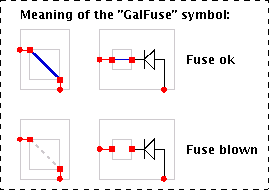

Applets
contents
visual index
 introduction
introduction std_logic_1164
std_logic_1164 gatelevel circuits
gatelevel circuits delay models
delay models flipflops
flipflops adders and arithm...
adders and arithm... counters
counters LFSR and selftest
LFSR and selftest memories
memories programmable logic
programmable logic
 PLA circuit
PLA circuit
 GAL output cell
GAL output cell
 GAL demo 1
GAL demo 1
 GAL demo 2
GAL demo 2
 GAL demo 3
GAL demo 3
 GAL demo 4
GAL demo 4
 ACT1 cell
ACT1 cell
 ACT1 AND3 gate
ACT1 AND3 gate
 ACT1 XOR2 gate
ACT1 XOR2 gate
 ACT1 SR-flip...
ACT1 SR-flip... state-machine editor
state-machine editor misc. demos
misc. demos I/O and displays
I/O and displays DCF-77 clock
DCF-77 clock relays (switch-le...
relays (switch-le... CMOS circuits (sw...
CMOS circuits (sw... RTLIB logic
RTLIB logic RTLIB registers
RTLIB registers Prima processor
Prima processor D*CORE
D*CORE MicroJava
MicroJava Pic16 cosimulation
Pic16 cosimulation Mips R3000 cosimu...
Mips R3000 cosimu... Intel MCS4 (i4004)
Intel MCS4 (i4004) image processing ...
image processing ... [Sch04] Codeumsetzer
[Sch04] Codeumsetzer [Sch04] Addierer
[Sch04] Addierer [Sch04] Flipflops
[Sch04] Flipflops [Sch04] Schaltwerke
[Sch04] Schaltwerke [Sch04] RALU, Min...
[Sch04] RALU, Min... [Fer05] State-Mac...
[Fer05] State-Mac... [Fer05] PIC16F84/...
[Fer05] PIC16F84/... [Fer05] Miscellan...
[Fer05] Miscellan... [Fer05] Femtojava
[Fer05] Femtojava FreeTTS
FreeTTS From the AMD PAL Device Data Book (1980):
Product terms with all fuses opened assume the logical HIGH state;
product terms connected to both true and complement of any single
input assume the logical LOW state:
Registers consist of D-type flip-flops that are loaded on the
LOW-to-HIGH transition of the clock. Unused input pins should be
tied to Vcc or GND.
Put together, the GAL programming shown in the applet implements
the following logical functions for each row of the GAL matrix:
From the AMD PAL Device Data Book (1980):
Product terms with all fuses opened assume the logical HIGH state;
product terms connected to both true and complement of any single
input assume the logical LOW state:
Registers consist of D-type flip-flops that are loaded on the
LOW-to-HIGH transition of the clock. Unused input pins should be
tied to Vcc or GND.
Put together, the GAL programming shown in the applet implements
the following logical functions for each row of the GAL matrix:
+ = fuse ok
. = fuse blown
A /A B /B X /X Y /Y function
+ + + + + + + + 0 (all fuses ok)
. . . . . . . . 1 (all fuses open)
+ . . . . . . . A
. + . . . . . . not A
. . . . . . . . 1
. . . . . . . . 1
+ . + . . . . . A AND B
. + . + . . . . !(A AND B)